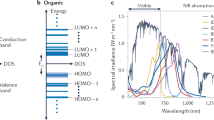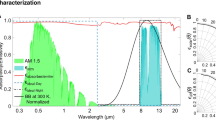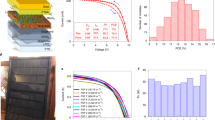Abstract
Semi-transparent organic photovoltaics (OPVs) are an emerging solar-energy-harvesting technology with promising applications, such as rooftop energy supplies for environmentally friendly greenhouses. However, the poor operational stability of OPVs poses challenges to their feasibility as incessantly serving facilities. Here we report a reductive interlayer structure for semi-transparent OPVs that improves the operational stability of OPVs under continuous solar radiation. The interlayer effectively suppresses the generation of radicals from the electron transport layer under sunlight and prevents the structural decomposition of the organic photoactive layer during operation. The defects that serve as the charge carrier recombination sites are nullified by the electron-donating functional groups of the reduced molecules, which improves photovoltaic performance. The semi-transparent OPVs demonstrate a power conversion efficiency of 13.5% and an average visible transmittance of 21.5%, with remarkable operational stability (84.8% retention after 1,008 h) under continuous illumination. Greenhouse results show that the semi-transparent OPV roof benefits the survival rate and growth of the crops, indicating the importance of our approach in addressing food and energy challenges.
This is a preview of subscription content, access via your institution
Access options
Access Nature and 54 other Nature Portfolio journals
Get Nature+, our best-value online-access subscription
$29.99 / 30 days
cancel any time
Subscribe to this journal
Receive 12 digital issues and online access to articles
$119.00 per year
only $9.92 per issue
Buy this article
- Purchase on Springer Link
- Instant access to full article PDF
Prices may be subject to local taxes which are calculated during checkout





Similar content being viewed by others
Data availability
All relevant data that support the findings of this study are presented in the article and Supplementary Information. Source data are available from the corresponding authors upon reasonable request.
References
Wu, A., Hammer, G. L., Doherty, A., von Caemmerer, S. & Farquhar, G. D. Quantifying impacts of enhancing photosynthesis on crop yield. Nat. Plants 5, 380–388 (2019).
Joshi, S. et al. High resolution global spatiotemporal assessment of rooftop solar photovoltaics potential for renewable electricity generation. Nat. Commun. 12, 5738 (2021).
Ballif, C., Perret-Aebi, L.-E., Lufkin, S. & Rey, E. Integrated thinking for photovoltaics in buildings. Nat. Energy 3, 438–442 (2018).
Li, G., Zhu, R. & Yang, Y. Polymer solar cells. Nat. Photon. 6, 153–161 (2012).
Hou, J., Inganäs, O., Friend, R. H. & Gao, F. Organic solar cells based on non-fullerene acceptors. Nat. Mater. 17, 119–128 (2018).
Chang, S.-Y., Cheng, P., Li, G. & Yang, Y. Transparent polymer photovoltaics for solar energy harvesting and beyond. Joule 2, 1039–1054 (2018).
Betancur, R. et al. Transparent polymer solar cells employing a layered light-trapping architecture. Nat. Photon. 7, 995–1000 (2013).
Traverse, C. J., Pandey, R., Barr, M. C. & Lunt, R. R. Emergence of highly transparent photovoltaics for distributed applications. Nat. Energy 2, 849–860 (2017).
Wang, D. et al. High-performance and eco-friendly semitransparent organic solar cells for greenhouse applications. Joule 5, 945–957 (2021).
Li, Y. et al. Color-neutral, semitransparent organic photovoltaics for power window applications. Proc. Natl Acad. Sci. USA 117, 21147–21154 (2020).
Wang, D. et al. High‐performance semitransparent organic solar cells with excellent infrared reflection and see‐through functions. Adv. Mater. 32, 2001621 (2020).
Li, Y. et al. High efficiency near-infrared and semitransparent non-fullerene acceptor organic photovoltaic cells. J. Am. Chem. Soc. 139, 17114–17119 (2017).
Ravishankar, E. et al. Achieving net zero energy greenhouses by integrating semitransparent organic solar cells. Joule 4, 490–506 (2020).
Kaltenbrunner, M. et al. Ultrathin and lightweight organic solar cells with high flexibility. Nat. Commun. 3, 770 (2012).
Burlingame, Q., Ball, M. & Loo, Y.-L. It’s time to focus on organic solar cell stability. Nat. Energy 5, 947–949 (2020).
Burlingame, Q. et al. Intrinsically stable organic solar cells under high-intensity illumination. Nature 573, 394–397 (2019).
Ghasemi, M. et al. A molecular interaction–diffusion framework for predicting organic solar cell stability. Nat. Mater. 20, 525–532 (2021).
Deschler, F. et al. The effect of ageing on exciton dynamics, charge separation, and recombination in P3HT/PCBM photovoltaic blends. Adv. Funct. Mater. 22, 1461–1469 (2012).
Jiang, Y. et al. Photocatalytic effect of ZnO on the stability of nonfullerene acceptors and its mitigation by SnO2 for nonfullerene organic solar cells. Mater. Horiz. 6, 1438–1443 (2019).
Li, Y. et al. Non-fullerene acceptor organic photovoltaics with intrinsic operational lifetimes over 30 years. Nat. Commun. 12, 5419 (2021).
Duan, L. & Uddin, A. Progress in stability of organic solar cells. Adv. Sci. 7, 1903259 (2020).
Hoke, E. T. et al. The role of electron affinity in determining whether fullerenes catalyze or inhibit photooxidation of polymers for solar cells. Adv. Energy Mater. 2, 1351–1357 (2012).
Luke, J. et al. Twist and degrade—impact of molecular structure on the photostability of nonfullerene acceptors and their photovoltaic blends. Adv. Energy Mater. 9, 1803755 (2019).
Gokulnath, T. et al. A wide-bandgap π-conjugated polymer for high-performance ternary organic solar cells with an efficiency of 17.40%. Nano Energy 89, 106323 (2021).
Jiang, H. et al. Passivated metal oxide n-type contacts for efficient and stable organic solar cells. ACS Appl. Energy Mater. 3, 1111–1118 (2019).
Palilis, L. C. et al. Inorganic and hybrid interfacial materials for organic and perovskite solar cells. Adv. Energy Mater. 10, 2000910 (2020).
Larson, R. A. & Berenbaum, M. R. Environmental phototoxicity. Environ. Sci. Technol. 22, 354–360 (1988).
Mackerness, S. A.-H. Plant responses to ultraviolet-B (UV-B: 280–320 nm) stress: what are the key regulators? Plant Growth Regul. 32, 27–39 (2000).
Caldwell, M. Physiological Plant Ecology I (Springer, 1981).
Perdew, J. P., Burke, K. & Ernzerhof, M. Generalized gradient approximation made simple. Phys. Rev. Lett. 77, 3865–3868 (1996).
Perdew, J. P. et al. Restoring the density-gradient expansion for exchange in solids and surfaces. Phys. Rev. Lett. 100, 136406 (2008).
Grimme, S. Semiempirical GGA-type density functional constructed with a long-range dispersion correction. J. Comp. Chem. 27, 1787–1799 (2006).
Kresse, G. & Furthmüller, J. Efficiency of ab-initio total energy calculations for metals and semiconductors using a plane-wave basis set. Comput. Mater. Sci. 6, 15–50 (1996).
Kresse, G. & Furthmüller, J. Efficient iterative schemes for ab initio total-energy calculations using a plane-wave basis set. Phys. Rev. B 54, 11169 (1996).
Zang, L. Y. & Misra, H. P. EPR kinetic studies of superoxide radicals generated during the autoxidation of 1-methyl-4-phenyl-2,3-dihydropyridinium, a bioactivated intermediate of parkinsonian-inducing neurotoxin 1-methyl-4-phenyl-1,2,3,6-tetrahydropyridine. J. Biol. Chem. 267, 23601–23608 (1992).
Schneider, C. A., Rasband, W. S. & Eliceiri, K. W. NIH Image to ImageJ: 25 years of image analysis. Nat. Methods 9, 671–675 (2012).
Maldonado, M., Ribes, M. & van Duyl, F. C. Nutrient fluxes through sponges: biology, budgets, and ecological implications. Adv. Mar. Biol. 62, 113–182 (2012).
Young, H. E., Schlegel, H. G. & Barnea, J. (eds) Microbial Energy Conversion (Pergamon, 1977).
Zhu, J. et al. Improved productivity of neutral lipids in Chlorella sp. A2 by minimal nitrogen supply. Front. Microbiol. 7, 557 (2016).
Pandey, A., Larroche, C. & Ricke, S. C. (eds) Biofuels: Alternative Feedstocks and Conversion Processes (Academic, 2011).
Acknowledgements
This work is supported by the California Energy Commission (grant no. EPC-19-002). Computing resources used in this work were provided by the National Center for High Performance Computing (UHeM) of Turkey (grant no. 1008342020). C.D. would like to thank the Fulbright Turkey Commission for providing a valuable scholarship for his post-doctoral study in the United States. M.W. acknowledges financial support from the National Natural Science Foundation of China (NSFC) (grant nos 12104081 and 51872036) and China Postdoctoral Science Foundation (grant no. 2022T150087). M.P. acknowledges financial support from the National Science Foundation Research in Undergraduate Institutions (RUI) (grant no. 1856746).
Author information
Authors and Affiliations
Contributions
Y. Zhao and Y. Yang conceived the idea. Y. Zhao conducted the experiments and prepared the paper under the supervision of Y.Y. C.D. and I.Y. performed the DFT calculations. Z.L. prepared the samples for EQE, GIWAX and XPS measurements. Z.L. collected GIWAX data of the films. M.P. conducted the EPR measurements. Q.X. helped with the XPS measurements. M.W. and Y. Yin collected electrochemical impedance spectroscopy and TPC data under the supervision of Y.S. and J.B. Z.L. and X.W. built the PV-integrated greenhouses and did the correlated plant observation under the sunlight. B.C. and E.G.S. helped with the estimation of biomass productivity and concurrent electricity production under the supervision of K.-H.W. W.Y., Y. Zhou, D.M., E.Z., R.Z., Y.S. and K.N.H. provided helpful discussion during the project and revised the paper. All the authors discussed the results and commented on the paper.
Corresponding authors
Ethics declarations
Competing interests
The authors declare no competing interests.
Peer review
Peer review information
Nature Sustainability thanks Chang-Zhi Li, Jianhui Hou and the other, anonymous, reviewer(s) for their contribution to the peer review of this work.
Additional information
Publisher’s note Springer Nature remains neutral with regard to jurisdictional claims in published maps and institutional affiliations.
Extended data
Extended Data Fig. 1 Surface morphology of the ZnO layer with and without L-G interlayer.
AFM images of the ZnO surface a, without and b, with the L-G interlayer, and three-dimensional AFM images of ZnO films c, without and d, with L-G interlayer.
Extended Data Fig. 2 Suppression of superoxide radical generation with the L-G interlayer.
EPR spectra of the ZnO films a, without and b, with the L-G interlayer.
Extended Data Fig. 3 Suppression of hydroxide radical generation with the L-G interlayer.
a, Reaction that the coumarin transforms into 7-hydroxycoumarin by reacting with hydroxide radicals. b, PL intensity change at 456 nm of the solution immersed with ZnO films with and without L-G interlayer.
Extended Data Fig. 4 Light and heat stability enhancements of unencapsulated devices.
a, PCE changes of the devices with and without L-G interlayer during 502-hour exposure under continuous illumination. b, PCE changes of the devices with and without L-G interlayer during 502-hour heating in nitrogen glovebox.
Extended Data Fig. 5 Morphological stability of the active layers on ZnO surfaces.
AFM images of the PM6/Y6 active layers on the ZnO surfaces a, c, without and b, d, with the L-G interlayer before and after heating in the nitrogen glovebox for 500 hours.
Extended Data Fig. 6 Growth condition of the mung bean in the greenhouses.
Photos that show the growth condition of the mung bean in the greenhouses with roofs of spatially segmented inorganic solar cell, semitransparent OPV, and transparent glass.
Extended Data Fig. 7 Growth condition of the wheat in the greenhouses.
Photos that show the growth condition of the wheat in the greenhouses with roofs of spatially segmented inorganic solar cell, semitransparent OPV, and transparent glass.
Extended Data Fig. 8 Growth condition of the broccoli in the greenhouses.
Photos that show the growth condition of the broccoli in the greenhouses with roofs of spatially segmented inorganic solar cell, semitransparent OPV, and transparent glass.
Supplementary information
Supplementary Information
Supplementary Figs. 1–9 and Tables 1–5.
Rights and permissions
Springer Nature or its licensor (e.g. a society or other partner) holds exclusive rights to this article under a publishing agreement with the author(s) or other rightsholder(s); author self-archiving of the accepted manuscript version of this article is solely governed by the terms of such publishing agreement and applicable law.
About this article
Cite this article
Zhao, Y., Li, Z., Deger, C. et al. Achieving sustainability of greenhouses by integrating stable semi-transparent organic photovoltaics. Nat Sustain 6, 539–548 (2023). https://doi.org/10.1038/s41893-023-01071-2
Received:
Accepted:
Published:
Issue Date:
DOI: https://doi.org/10.1038/s41893-023-01071-2



